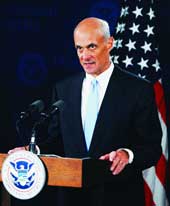Mixed signals for RFID

Despite Chertoff's rejection, PASS card project moves ahead.
Homeland Security Department Secretary Michael Chertoff has rejected using radio frequency identification technology in a border-crossing program, calling it a failure. Despite his criticism, DHS is preparing to use RFID tags in another border-crossing program.RFID didn't work in the U.S. Visitor and Immigrant Status Indicator Technology program, Chertoff said recently. Industry executives say more problems could lie ahead for the department's plans to use RFID technology for the upcoming People Access Securities Services (PASS) identification card."We don't understand how DHS can go forward with the same solution for the PASS card," said Kelli Emerick, executive director of the Secure ID Coalition, an industry group of smart card, chip and RFID makers. "It is the same technology as the one used in US-VISIT."Industry experts suggest the RFID technology is not at fault in the US-Visit tests, but rather problems arose in how DHS applied it.Nonetheless, given the RFID failures in US-VISIT, there is uncertainty about how the department intends to proceed in using RFID in the PASS card, said Walter Hamilton, chairman of the International Biometric Industry Association, an industry group."It certainly is a valid question," Hamilton said.The two card programs are related. The PASS card program, jointly administered by DHS and the State Department, will issue a low-cost alternative to a passport for U.S., Mexican and Canadian citizens who frequently cross U.S. borders.Under a notice issued in October 2006, DHS said the PASS cards would use ultra-high-frequency vicinity RFID tags that readers can scan at distances of several feet. "Vicinity RFID technology will be a force multiplier for our Customs and Border Protection officers," said Ralph Basham, commissioner of Customs and Border Protection, in a statement released with the notice.Vicinity RFID is used in highway toll programs, and other DHS programs that provide special ID cards to ease border passage for truck drivers, day laborers and others who frequently cross U.S. borders.The PASS card notice also touted the deployment of 459,000 RFID tags in the US-VISIT exit program. In those tests, foreign visitors at several crossings along the borders received an I-94 document with an embedded RFID tag. When they exited the country, readers suspended above the exit lanes wirelessly scanned the RFID tags. To protect privacy, the RFID tags had only a number linked to a DHS database that had biometric information on the visitor who was issued the document.But according to the Government Accountability Office, the department encountered numerous performance and reliability problems with the RFID tests in US-VISIT. The readers were not able to detect a majority of the RFID tags, GAO said. For example, out of 166 RFID tags that passed through the Blaine-Pacific Highway border station in one week, only 14 percent were read correctly, GAO said. The goal was 70 percent accuracy."The RFID test proved, as GAO indicated, unsuccessful," Chertoff told the House Homeland Security Committee Feb. 9."I mean, this is the real world," Chertoff said. "I think, yes, we're abandoning it. That's not going to be a solution. So in the real world, when something fails, we drop it, and we move to the next thing."DHS and State officials did not respond to phone calls requesting comment. However, technology experts said RFID is not at fault. They blamed the application of the RFID technology, including what the requirements are, how the readers are placed, and how everything operates in the field."You have to look at the applications environment, the readers, how it is applied," said Dan Mullen, president of AIM Global, an RFID industry group. "There are a lot of factors involved."RFID could fail in an exit application, such as US-VISIT, that has little or no infrastructure to provide backup, said Guy Swope, senior biometrics architect at Raytheon Co., which has developed RFID-based solutions for ID cards, among other technologies. The same technology could be successfully used in an entry program, as it apparently has been in other DHS programs that provide special ID cards, Swope added.Another problem identified by GAO in the US-VISIT test was cross matching, in which the reading of an I-94 document experienced interference from readings of other I-94 documents in the vicinity. Multiple readers picked up multiple reads on the same document, GAO said. Correcting the problem could prove costly because it would require reconfiguring the readers.Other industry sources blame the US-VISIT test failures on malfunctioning or disconnected readers, not the RFID tags. DHS officials did not respond to requests for additional information.Meanwhile, even if the US-VISIT testing of the RFID had been successful, it still does not meet Congress' requirement that the United States track visitors by using biometrics, the GAO concluded. That is because there is no way to prove that the person displaying the I-94 document is the same person to whom it was issued.

Staff Writer Alice Lipowicz can be reached at alipowicz@1105media.com.

Michael Chertoff, secretary of Homeland Security, called radio frequency identification technology a failure.
Staff Writer Alice Lipowicz can be reached at alipowicz@1105media.com.

